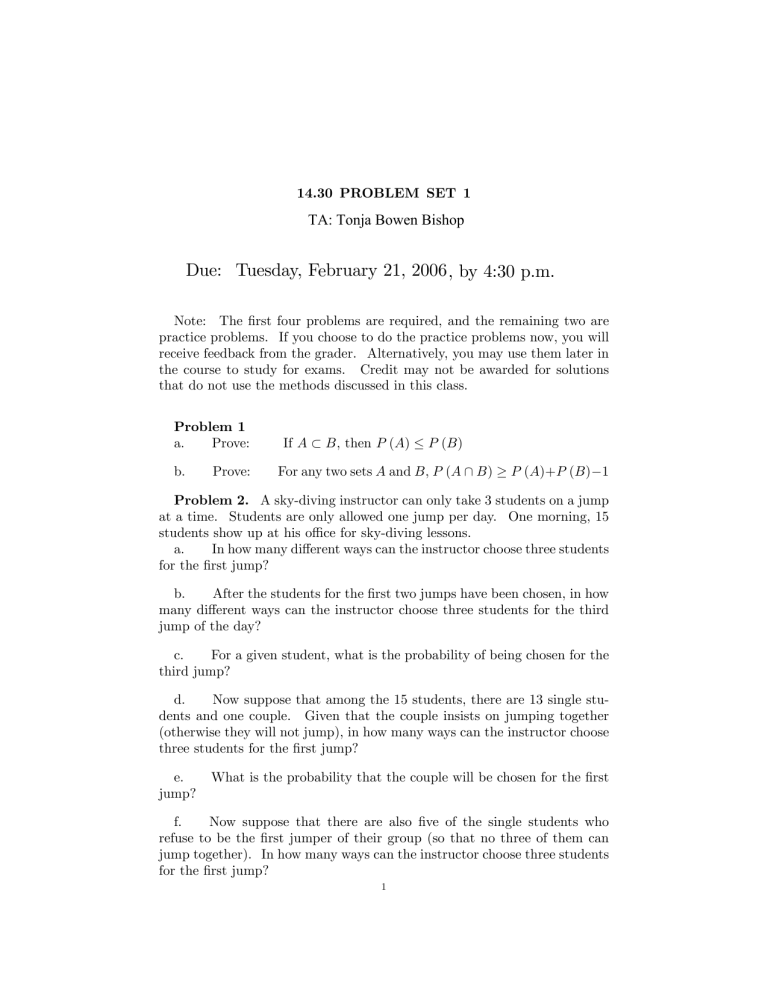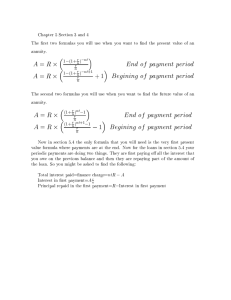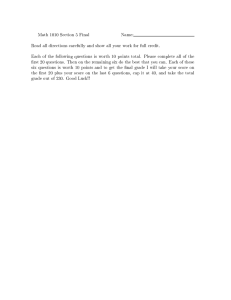Due: Tuesday, February 21, 2006, by 4:30 p.m.

14.30 PROBLEM SET 1
TA: Tonja Bowen Bishop
Due: Tuesday, February 21, 2006, by 4:30 p.m.
Note: The …rst four problems are required, and the remaining two are practice problems. If you choose to do the practice problems now, you will receive feedback from the grader. Alternatively, you may use them later in the course to study for exams.
Credit may not be awarded for solutions that do not use the methods discussed in this class.
Problem 1 a.
Prove: If A B , then P ( A ) P ( B ) b.
Prove: For any two sets A and B , P ( A \ B ) P ( A )+ P ( B ) 1
Problem 2.
A sky-diving instructor can only take 3 students on a jump at a time. Students are only allowed one jump per day. One morning, 15 students show up at his o¢ ce for sky-diving lessons.
a.
In how many di¤erent ways can the instructor choose three students for the …rst jump?
b.
After the students for the …rst two jumps have been chosen, in how many di¤erent ways can the instructor choose three students for the third jump of the day?
c.
For a given student, what is the probability of being chosen for the third jump?
d.
Now suppose that among the 15 students, there are 13 single students and one couple.
Given that the couple insists on jumping together
(otherwise they will not jump), in how many ways can the instructor choose three students for the …rst jump?
e.
jump?
What is the probability that the couple will be chosen for the …rst f.
Now suppose that there are also …ve of the single students who refuse to be the …rst jumper of their group (so that no three of them can jump together). In how many ways can the instructor choose three students for the …rst jump?
1
2 14.30 PROBLEM SET 1 g.
Now what is the probability that the couple will be chosen for the
…rst jump?
Problem 3.
(Note: The …gures in this problem are for illustrative purposes only)
Recent studies have shown that 1 in every 20 women have breast cancer.
The cancer research institute has recently developed a new screening test for early detection of breast cancer. Because this technology is new, it is not
100% reliable. Among women who actually have breast cancer, the test will correctly detect the disease in 80% of them. In addition, it will erroneously produce a positive result for 10% of women without breast cancer.
a.
Given that a patient received a positive test result, what is the probability that she has breast cancer?
b.
Given that her screening test did not detect breast cancer, what is the probability that a woman is cancer free?
Problem 4.
In the 17th century, Italian gamblers used to bet on the sum of three dice.
They believed that the chance of rolling a total of 9 ought to be the same as the chance of rolling a total of 10. This is because there are six di¤erent combinations that will result in a 9 {(1,2,6), (1,3,5),
(1,4,4), (2,2,5), (2,3,4), (3,3,3)}, and six di¤erent combinations that will result in a 10 {(1,3,6), (1,4,5), (2,2,6), (2,3,5), (2,4,4), (3,3,4)}.
Thus the gamblers argued that a 9 and a 10 should have the same chance of appearing.
However, empirically this turned out not to be the case. Galileo solved the gamblers problem. How?
Problem 5.
Five cards are dealt at random from a standard deck of 52 cards. Standard decks contain four suits (spades, hearts, clubs, diamonds), each with 13 denominations (2-10, Jack, Queen, King, Ace). Determine the probability of being dealt the following hands.
a.
Five cards of the same suit b.
Two pairs. (Each pair is two cards of the same denomination. We assume that the two pair do not together make four of a kind, and that the
…fth card does not make a triple.) c.
Three of a kind. (This is three cards of the same denomination, where the fourth and …fth cards are not a pair themselves, and do not make four of a kind with the triple.) d.
e.
Four of a kind. (Four cards of the same denomination)
Four aces.
Problem 6.
Suppose there are two types of drives, safe and unsafe.
An insurance company knows that 50% of drivers are unsafe, and an unsafe
14.30 PROBLEM SET 1 3 driver has a 40% chance of having an accident each year, but a safe driver has only a 10% chance of an accident each year.
However, the company does not know whether a new policy holder is safe or unsafe. Assume that for a given driver, accidents are independent (and that drivers never have more than one accident).
a.
What is the probability that a new policy holder has an accident the …rst year?
b.
What is the probability that a new policy holder that does not have an accident in the …rst year is unsafe?
c.
The insurance company keeps track of accident records to determine whether a driver is safe or unsafe. How many years in a row would a policy holder have to have an accident before the insurance company is 90% sure that the driver is unsafe?






